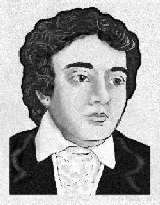
Born: October 29 (or 31), 1795, in Moorfields, London, England
Died: February 23, 1821, in Rome, Italy
Keats is widely regarded as the most talented of the immortal English romantic poets. Of all the words he wrote, the most ironic exist in his epitaph: "Here lies one whose name was writ in water."
Keats was the oldest of four children orphaned in 1810. Their father, who had managed a stable, died when Keats was nine and their mother died six years later. His brothers, George and Tom, and his sister Fanny were cared for by guardians.
Despite their gloomy initiation into the world, the boys attended school at Enfield where Keats met Charles Cowden Clarke, the headmaster's son. Clarke and Keats shared in the pleasures of Spencer's Faerie Queene, which later became an inspiration for the young romantic.
His youth was an example of the multiple influences of Victorian society. The first influence was social pressure which dictated he must hold a profession. In 1811 Keats was apprenticed to a surgeon in Edmonton. The second influence, pertaining to literature, was the writings of the ancient Greek and Roman scholars. Around the time he began his medical studies he finished his first translation of Virgil's Aeneid. However, the pleasure of writing seemed to influence him the most. Although he was a promising surgeon he moved to London to pursue a vocation as a poet.
Once again his schoolmate, Clarke, helped Keats in the capital. Clarke showed Keats' verses to Leigh Hunt, the influential publisher and editor. Hunt was known for championing young authors and introduced Keats and his contemporary, Shelley, to the public. Keats' first important poem, On First Looking into Chapman's Homer was published in Leigh Hunt's newspaper, The Examiner, in 1815.
However, the association with Hunt proved detrimental. The reviews of Keats' first anthology, Poems published in 1817, labeled his poetry as Cockney. In fact the entire circle of young poets Hunt was promoting was unfavorably portrayed as members of the Cockney School, indicating the lower class from which they came. Keats' poetry eventually won over many of these critics but his humble background was an impediment he would constantly struggle with for the rest of his career.
After the publication of his first book, which was considered to be promising, but immature, he settled on the Isle of Wight and began work on Endymion, published in 1818. It is considered the most classical of Keats' work. It displays many of the traits of Greek art in a time of its a renaissance in England.
Following Endymion, Keats explored the Scottish highlands on foot, accompanied by his friend Charles Armitage Brown. That summer Keats developed tuberculosis. He may have come in contact with the disease from his brother Tom who died late in 1818.
After Tom's death, and his other brother George and his wife had moved to America, Keats went to live with Brown at Hampstead and began work on Hyperion. During his stay at Hampstead Keats succumbed to advanced stages of tuberculosis and love. As Dante was inspired by Beatrice Portinari, Keats was inspired by Fanny Brawne. The seventeen year old beauty lived nearby, and continues to live in his love poems such as The Eve of St. Agnes, La Belle Dame sans Merci, and the ode To a Nightingale. His passion spawned other poems such as On a Grecian Urn, To Psyche, and On Melancholy.
In February 1820 he realized he was dying and published his final work, Lamia, Isabella, The Eve of St. Agnes, and Other Poems. In September, he sailed for Rome with his friend and artist, Joseph Severn. He died there and was buried in the Roman Protestant cemetery.
"THE DAY IS GONE, AND ALL ITS SWEET ARE GONE",1819